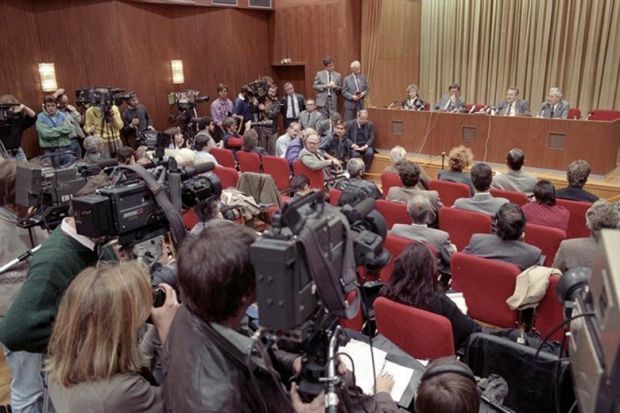In the wake of the momentous political changes of 2016, the role of the media and how they predict and report, analyse and spin the news has become headline material in its own right. Julia Sonnevend’s impressively clear and engaging Stories without Borders is therefore a timely publication. Taking her cue and moving on from studies by Daniel Dayan and Elihu Katz, she analyses how a story can unfold in a variety of media over time and across national borders. The fall of the Berlin Wall in November 1989 is a case study of undoubtable historic significance: the mere mention of the date still triggers images of what was, in the best possible sense, “people power”. In fact, these images work well beyond the generation that actually experienced the end of the Iron Curtain.
Sonnevend differentiates the event’s narrative dimensions. The chapter “Foundation” deals with the symbolic significance of the Wall – its origins and ending, facilitating the selection of memorable developments. “Mythologization” highlights how the press use elevated language in lieu of detailed engagement with facts. To this purpose, Sonnevend offers striking examples of just how slow the media were to acknowledge what happened in Berlin that night. Key in this chapter is Günter Schabowski’s botched press conference about the German Democratic Republic’s new travel regulations on the evening of 9 November and how journalists responded to this. Even the American coverage “built up the event gradually, step by step turning an awkward occurrence into an international symbol”.
“Condensation” stands for the soundbites that affirm our sense of “before” and “after” over time: 9 November 1989 comes to represent “the end of division”, or, more vaguely but also more exciting, “freedom”. In this phase, physical and visual embodiments of otherwise too complex developments came to the fore: the image of cheering crowds gathering on and along the Wall at the Brandenburg Gate sums up decades of history in the making. “Counter-narration”, the penultimate step in Sonnevend’s process of transnational storytelling, reflects the Soviet Union’s and East Germany’s “under-narration” of these events. In contrast to Western approaches, there is, then, no “resonant social myth” that proved fundamental for our understanding of 20th-century history. Finally, “Remediation” deals with the multiple forms of ongoing memorialisation, whether in anniversaries, artistic engagements, matters of public relations or even a re-enactment of the event in Legoland Berlin. The fall of the Berlin Wall now represents something larger.
The story of the Berlin Wall has done nothing to prevent new walls, Sonnevend acknowledges – but its fall facilitates “a common vocabulary and a common conceptual framework”. Arguably, the example of the Berlin Wall provides a particularly telling narrative, but the principal patterns she proposes are thought-provoking and translate well to other topics. However, if the way the media create highly symbolic global stories and this process “helps” us to identify with topics, then it is just as interesting to muse over the obvious lack of some stories. Tellingly, the European Union, steeped in history, rich in events, has never been afforded this kind of mediated and spellbinding narrative of global relevance.
Ulrike Zitzlsperger is associate professor of German, University of Exeter.
Stories without Borders: The Berlin Wall and the Making of a Global Iconic Event
By Julia Sonnevend
Oxford University Press, 230pp, £64.00 and £16.99
ISBN 9780190604301 and 4318
Published 27 October 2016




